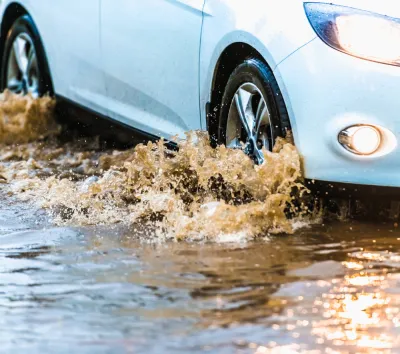Tires wear down and shed toxic microplastics into stormwater, which eventually ends up in rivers and the ocean. Recent research sheds new light on the extent of the damage.

Laura Trethewey shares details of ongoing research into the pollution created by the tires of cars—toxic waste that ends up in rivers and oceans and must be considered alongside particulate pollution and climate change emissions from the tailpipes of cars.
Trethewey is detailing research by a team at the San Francisco Estuary Institute (SFEI), recently testing water at 12 stormwater outlets around the Bay Area for three years, finding an estimated 7.2 trillion synthetic particles washing into San Francisco Bay each year.
In California, where most commuters cling to their cars, conversations about the environmental impact of automobiles usually involve what spews from tailpipes. Electric vehicles are sold as the solution for car emissions. But SFEI’s work has expanded the debate about the environmental impacts of cars to include tires shedding particles near the sea.
It's hard to change the nature of tires. They shed by design and engineering, according to the article, and recent changes in the science of tires has created a difficult-to-recycle product that also has consequences for landfills.
Other researchers around the world are studying the impact of tires on water quality, but an idea of the global scope of the problem is still being developed, but researchers have found a lot of bad news already, according to Trethewey.
In 2017, the International Union for Conservation of Nature estimated that 28.3 percent of microplastics in the ocean come from tires, landing them in the top seven contributors. But the real number is likely higher. A study published in July suggests that vast quantities of tire fragments find their way into the ocean not just via rivers and waterways, but also through the air. Swept on the wind, they drift far from where they are shed. The study warned that so many tire particles are landing in the Arctic that they pose a climate change risk. By turning the snowy tundra a less reflective white, the polluted Arctic ice may absorb more light and melt even faster.
The fresh news about the environmental impacts of tires led to quite a bit of discussion on social media in recent days, as anti-car advocates used the news to throw a bit of cold water on the idea of electric cars as a panacea for the negative externalities of automobiles. Others pushed back, saying electric cars are an essential step in the right direction in the fight to prevent the worst effects of climate change.
FULL STORY: When Rubber Hits the Road—and Washes Away

Analysis: Cybertruck Fatality Rate Far Exceeds That of Ford Pinto
The Tesla Cybertruck was recalled seven times last year.

National Parks Layoffs Will Cause Communities to Lose Billions
Thousands of essential park workers were laid off this week, just before the busy spring break season.

Retro-silient?: America’s First “Eco-burb,” The Woodlands Turns 50
A master-planned community north of Houston offers lessons on green infrastructure and resilient design, but falls short of its founder’s lofty affordability and walkability goals.

Test News Post 1
This is a summary

Analysis: Cybertruck Fatality Rate Far Exceeds That of Ford Pinto
The Tesla Cybertruck was recalled seven times last year.

Test News Headline 46
Test for the image on the front page.
Urban Design for Planners 1: Software Tools
This six-course series explores essential urban design concepts using open source software and equips planners with the tools they need to participate fully in the urban design process.
Planning for Universal Design
Learn the tools for implementing Universal Design in planning regulations.
EMC Planning Group, Inc.
Planetizen
Planetizen
Mpact (formerly Rail~Volution)
Great Falls Development Authority, Inc.
HUDs Office of Policy Development and Research
NYU Wagner Graduate School of Public Service




























